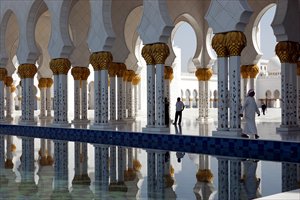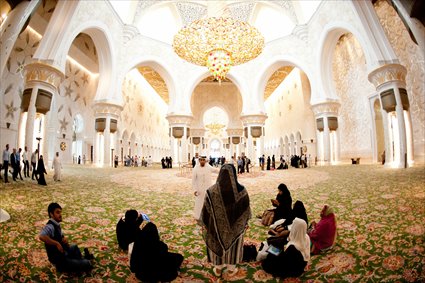Abu Dhabi delights

This week's destination

The splendid Sheik Zayed Grand Mosque Photo: IC

The splendid Sheik Zayed Grand Mosque Photo: IC
Glitzy skyscrapers, state-of-the-art architecture and shiny shopping malls are probably the first thing that crosses one's mind even before setting foot in Abu Dhabi's airport and, to a large extent, this is a rather accurate thought. Sun-drenched Abu Dhabi is the capital of the UAE, acronym for United Arab Emirates, one of the world's youngest nations.
The UAE as the country we know today is pretty young: the British withdrew in 1968 and the seven emirates, that until then were mainly desert lands organized in tribes, decided to unite in 1971. For centuries Bedouin life was going on peacefully across the shifting sands of those immense apricot-hued dunes. Then oil happened, and the Emirates swiftly imposed themselves on the world map. High-rise buildings started mushrooming, new restaurants releasing all types of international flavors were opened, and sumptuous hotels began welcoming tourists from the world over.
Even though when I booked my ticket to Abu Dhabi I already knew I was going to be surrounded by modernity and opulence. I never gave up on the idea of unearthing whatever was left of the country's authentic traditions, from its food to its crafts to its spirituality. And the spiritual side was precisely what I decided to explore first, by visiting the city's biggest - and most spectacular - worship place.
Spiritual side
Sheik Zayed Grand Mosque, named after the country's first president and Abu Dhabi ruler, stands out from the crowd, its 82 imposing domes easily dominating the skyline. This huge Islamic sanctuary is made of flawless snow-white marble coming from all over the world, and its visitors can't help gaping at the Swarovski-flecked chandeliers hanging from finely decorated ceilings, its walls reproducing stylized flowers and its floor covered with the world's biggest Persian carpet, a vast green meadow, just like Sheik Zayed, who spent most of his life in the desert, had always yearned for.
An opulence that many don't consider in line with spirituality, the complex includes also the burial site of beloved Sheik Zayed, and its domes can be seen from all the bridges connecting the island to the main land. With the capacity to accommodate some 40,000 worshipers, the place is capable of instilling a sense of peace and tranquility, and silent abaya-clad ladies gliding in towards their prayer area complete the middle eastern scene.
Soaking in local life
While westernized patterns have become overly familiar in the UAE, also thanks to the waves of Europeans who moved there for business, it's impossible not to notice how Emiratis of all ages enjoy preserving their traditional leisure habits, from smoking a flavored hookah, a typical middle eastern waterpipe, while sitting in a palm-shaded garden waiting for the evening to give them a break from the usual blazing heat. Or, picnicking in the desert among the great sweep of sandy mountains that still occupy a large part of the territory, despite all the construction work claiming more space by the day.
I was aware that those dunes were the real deal for anyone in the quest for the original Bedouin identity. But before going into the wild, I planned a visit to the city's Heritage Village, near the glittery shopping center Marina Mall, with the idea to soak in local folklore. As I stepped over the artificial threshold, all the most traditional symbols of bygone tribal life started coming my way as a fascinating sequence of local artisans creating colorful blown-glass marvels, weaving carpets and making pottery.
Abu Dhabi vs Dubai
Although the emirates are seven in total, two have better managed to impose themselves on the map. Dubai has probably held the record of being the most glamorous and, why not, scandalous sister in the family for years. In eternal competition with Abu Dhabi and the rest of the world, Dubai's leaders have always sought, quite successfully, to score all possible records. From the world's tallest tower Burj Khalifa soaring an astonishing 828 meters, to the world's most bizarre (and beautiful) man-made palm-shaped archipelago, aptly named Palm Jumeirah, Dubai has the hotels, restaurants and all other necessary ingredients to boost a tourism-driven economy. It also hosts one of the world's most luxurious hotels, the sail-shaped Burj al Arab, to prove, if it was still necessary, that Dubai's tourism board does know how to pamper its visitors.
Everything about Dubai seems to shout. A cluster of shiny buildings and shopping malls selling most famous European brands as well as upscale restaurants and clubs are often seen as to be relentlessly leading to the decline of the country's primordial spirit.
Its direct neighbor, Abu Dhabi, appears to be clinging to tradition in a stronger and more determinate way, but the seemingly unlimited oil reserves have taken their toll on authenticity.
The capital looks as if struggling to retain the original spirit of desert nomads, a main part of its heritage. This is when, after delving into its religious side, handicrafts and its rival Dubai, I was ready to explore the legendary desert.
Experiencing the desert
A thrilling drive in an SUV on the huge dunes that form the Emirates' desert was only the beginning of what would have been my first time in such a huge sandy landscape. After the reckless roller coaster, our afternoon safari carried on with a taste of what life was before the oil. At a camel farm near a traditional tent where the few Emiratis proud and protective of their original Bedouin roots still live, apart from feeding the majestic "ships of the desert," we were also given the opportunity to ride them. Or at least try, given their size is only fully perceivable only from the saddle.
Despite all the fancy buildings still under construction in the main emirate, the desert still constitutes the greatest part of the country. We entered the desert under the scorching sun and only a couple of hours later we were covered in cool, the cooler evening breeze much welcomed by the locals.
Not that we paid too much attention to temperature changes, as we were ready to enjoy the next attraction on the plan: sunset. While setting behind the hazy skyline, the sun gilded the top of the giant dunes, making us appreciate even more our time away from the hustle and bustle of the modern city.
Our wait for the fleeting and stunning sundown paid off. After celebrating and taking countless pictures, we headed for the last part of our safari. It was an evening out in proper Arabian style: We tucked into local delicacies, enjoyed a belly-dancing show, got henna tattoos and smoked apple-flavored shisha. It was only a short while, but this was as local as I could get.
Meet Sheik Zayed
A trip to Abu Dhabi can't be considered complete without paying a full tribute to the nation's father and first President, Sheik Zayed bin Sultan Al Nahyan. This is not a hard task, thanks to the hundreds of portraits found in every corner of the city.
However, if your intention is to dig deeper into the country's history and birth, a day out in lovely Al Ain is a must. This city within the Abu Dhabi emirate, blessed with lush vegetation and a spectacular red desert, sits on the very border with the Sultanate of Oman.
As soon as I arrived, I headed to Sheik Zayed's walled residence. Once within the pastel-colored palace, his unassuming lifestyle becomes clear. Visitors are met with an unadorned office, poorly decorated living rooms and austere bedrooms. All spaces are garnished in simple Arabian style inspired by the nomadic roots of their dwellers. They are framed with thick walls in order to chase the pitiless heat away and embellished with long horseshoe banquettes covered with colorful cushions. In the middle of every room is the necessary equipment for making traditional Arabic coffee.
There's no doubt that fast development has brought huge change to the UAE. But even in a city known as the epitome of a man-made marvel, you can unearth the primordial spirit that led to today's achievements. I have since returned to Abu Dhabi a second time, and once again enjoyed the captivating collaboration of old and new, the beguiling allure of the mysterious Middle East.
Rules of Thumb
Practical information: The local currency in Abu Dhabi is the dirham. Both traveling and eating are not expensive, be it at the many shopping malls' eateries or proper restaurants. Entrances at the Heritage Village and at Sheik Zayed's residence in Al Ain are free of charge.
What to say: While the official language is Arabic, English is widely spoken everywhere in both Abu Dhabi and the rest of the UAE.
When to go: Thanks to the good weather, any season is a good time to visit, but if you want to avoid the blazing heat, the best months are January, February, March and December.
Where to stay: In Abu Dhabi and all of the UAE you can book all kinds of accommodation from opulent five-star hotels to budget guesthouses with prices starting from about $50-70 per night a double room.
Transportation: While Abu Dhabi has buses and trams, taxi fares are reasonable and the best way to move around. Estimated to be operational by 2016-2017, the Abu Dhabi metro will connect the islands forming the main Emirate to each other and to the main points of interest such as Zayed Sport City and Abu Dhabi International Airport.